I have been following the Java Game Programming for Beginners tutorial series, and wished to experiment by applying a background image. Unfortunately, when I render it through the paintComponent method, it moves with my sprite (albeit at one unit continuously as opposed to five); and when I render it through the paint method, I get a strange, flickering box that matches the color designated in the setBackground (color) property of the JFrame and it moves with the sprite identically to that of the prior instance (within paintComponent).
How might I code the image so as to remain static, as a background should be?
Code:
public class JavaGame extends JFrame{
int x, y;
private Image dbImage;
private Graphics dbg;
Image ghost;
Image bg;
public class AL extends KeyAdapter{
public void keyPressed(KeyEvent e){
int keyCode = e.getKeyCode();
if(keyCode == e.VK_LEFT){
if(x <= 8)
x = 8;
else
x += -5;
}
if(keyCode == e.VK_RIGHT){
if(x >= 235)
x = 235;
else
x += +5;
}
if(keyCode == e.VK_UP){
if(y <= 18)
y = 18;
else
y += -5;
}
if(keyCode == e.VK_DOWN){
if(y >= 235)
y = 235;
else
y += +5;
}
}
public void keyReleased(KeyEvent e){
}
}
public JavaGame(){
//Load images
ImageIcon i = new ImageIcon("C:/Users/Taylor/workspace/Java game/src/ghost.png");
ghost = i.getImage();
ImageIcon j = new ImageIcon("C:/Users/Taylor/workspace/Java game/src/bg.png");
bg = j.getImage();
//Game properties
addKeyListener(new AL());
setTitle("Java Game");
setSize(500, 500);
setResizable(false);
setVisible(true);
setBackground(Color.GRAY);
setDefaultCloseOperation(JFrame.EXIT_ON_CLOSE);
x = 150;
y = 150;
}
public void paint(Graphics g){
g.drawImage(bg, 0, 0, null);
dbImage = createImage(getWidth(), getHeight());
dbg = dbImage.getGraphics();
paintComponent(dbg);
g.drawImage(dbImage, x, y, this);
}
public void paintComponent(Graphics g){
g.setColor(Color.WHITE);
g.drawImage(ghost, x, y, this);
repaint();
}
public static void main(String[] args) {
new JavaGame();
}
Pictures:

